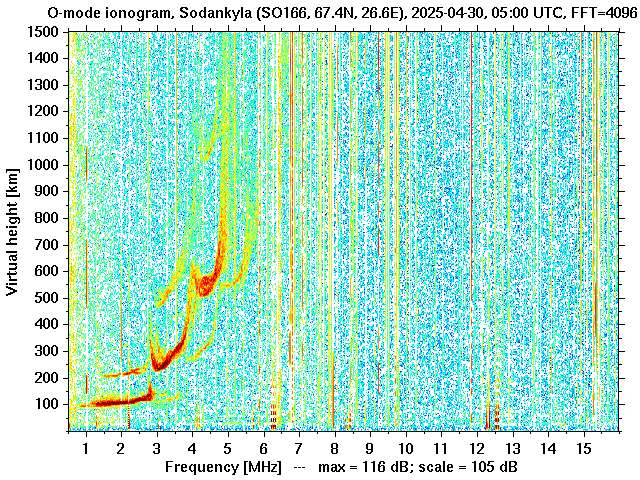Sodankylä Geophysical Observatory |
Ionospheric Situational Awareness (ISAw)
Ionogram traces can be rather complicated. Several attempts have been made to interpret ionograms automatically, but these do not work well in high latitudes, where space weather severely effects the ionosphere. In this project, we propose to use new techniques employing image recognition and modern methods of searching for similar images to make the analysis more efficient.
Regular measurements of the ionospheric structure by ionosondes are essential tools for radio communication by civil emergency services and are therefore important for national security of supply. Ionosonde observations, ionograms, are thus an important tool for Ionospheric and Space Situational Awareness, especially in high-latitude Northern Finland. Ionogram traces can be rather complicated. Several attempts have been made to interpret ionograms automatically, but these do not work well in high latitudes, where space weather severely effects the ionosphere. Consequently, high-quality ionograms of Sodankylä are manually interpreted by a specialist. In this project, we propose to use new techniques employing image recognition and modern methods of searching for similar images to make the analysis more efficient. We want to create a database for research and real-time analysis, which allows to match similar ionograms to one another and suggest an analysis solution.
The project Ionospheric Situational Awareness (ISaw) will combine ionospheric physics and machine learning/machine vision methods to create a catalogue of vertical ionospheric sounder (ionosonde) measurements. The catalogue will facilitate studies of past space weather events and serve as a base for rapid analysis of new measurement. The results will be validated against ionospheric measurements of the EISCAT incoherent scatter radars and other ionospheric measurements.
Sodankylä Geophysical Observatory (www.sgo.fi), established in 1914, carries out continuous, long-term geophysical measurements of Earth’s high-latitude and space-weather environment. The observation programme is a National Task and includes, among others, a number of ionospheric measurements using optical as well as active and passive radio methods including the high-power incoherent scatter radars of the EISCAT Scientific Association. At Sodankylä, SGO and the Arctic Space Centre of the Finnish Meteorological Institute form together the Sodankylä Space Campus, a highly multi-disciplinary, international, and stimulating research centre in the European Arctic. Our scientists routinely collaborate with more than 100 institutes world-wide.
For more information on the project, please contact: Dr Thomas Ulich, adj. prof. (thomas -dot- ulich -at- sgo -dot- fi).



